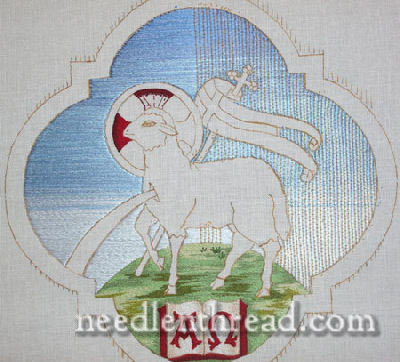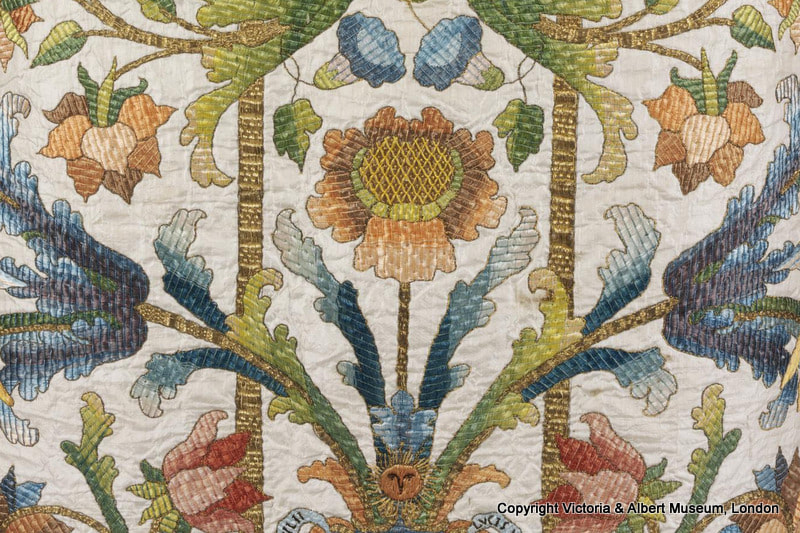|
When I visited the Diözesanmuseum Brixen in Italy last year, I was captivated by one chasuble particularly. It wasn't particularly old or made with extraordinary skill. But to me, it just screamed: FUN to embroider. And I had seen this particular technique before on an unfinished sampler in the collection of the Wemyss School of Needlework in Scotland. The particular pieces were made with fibrant coloured silks in a simple couching technique (Bayeux Stitch) and seem to originally date to the 17th century. Then my internet search began. I proved not to be the first to write about 'Italian couching'. In 2007, Mary Corbet wrote an article about 'Italian Stitching' on her blog Needle 'n Thread. Through the related articles, I found the book Mary had originally consulted: Church Embroidery and Church Vestments by Lucy MacKrille written in 1939. You can download it for free here. If you like goldwork embroidery and embroiderying with silk, you'll love it! And what does it say on 'Italian Stitch'?: Italian stitch in which stout floss is used for a foundation is the most beautiful of stitches. The floss is stretched across the surface from end to end of the design, care being taken not to twist a fibre, so that when the surface is covered it will be as smooth as satin. The finest gold thread is then laid across the silk in lines one-eight of an inch apart and couched evenly. The beauty of this stitch depends on the glossy smoothness of the floss, the straightness of the lines of gold, and the evenness of the bricking or couching stitches (MacKrille, 1939 p. 27-28). Hmm, not my 'Italian Couching' after all. The examples I saw in the Museums in Northern Italy were al couched with matching silks, not with gold thread. Could it be that 'Italian Stitch' was actually an Anglo-American invention and not of true Italian origin? Let's check with Pauline Johnstone writing on Italian Embroidery in 'Needlework: an illustrated history' edited by Harriet Bridgeman and Elizabeth Drury from 1978. There it says: An alternative technique was laid and couched work in colored silks, crossed and held down by spaced lines of gold thread. ... Many vestments of this type are attributed to Napels, where the Kings of Napels and the Two Sicilies held a wealthy and lucurious court (Plate 45). (Johnstone, 1978, p. 143). So, what does Plate 45 show? Not much in a book from 1978. It is in colour, but a whole chasuble at only 10,2x9,3 cm, doesn't tell a whole lot. Luckily, this particular chasuble is held at the Victoria & Albert Museum in London. And they have a digital archive! You can find the entry for the chasuble featured in the 1978 book here. Lo and behold! This is indeed the needlework technique I have seen in a few pieces in Northern Italy and the unfinished sampler in Scotland. And as you can see, the laid silk is couched with a matching silk thread. Not with a gold thread.
So, can you see what happened here? An authority on 'modern-day' church embroidery from America, but who studied embroidery in England, wrote on a couching technique with silks and gold thread she had learned and used in 1939. Later researchers on Italian needlework presumed this was a historical technique used in 17th century Italy. They had a bad photograph from the V&A collection and a brief description naming floss silks and silver-gilt thread. Combining the two into a Bayeux stitch with silks and gold thread. Now don't get me wrong. The Itialian Stitch embroidery executed by both Lucy MacKrille and Mary Corbet looks absolutely stunning. But it does not seem to have been a historical needlework technique in use in 17th century Italy. However, if you have come across a historical piece made in Italy which does use gold thread as the couching, please do let me know! In the mean time, I'll keep my eyes peeled for more pieces in this fascinating technique.
16 Comments
It's like the old game of "Chinese Whispers", isn't it, where the message that leaves isn't at all the one that arrives.
Reply
15/1/2018 13:00:02
Oh, that's a good one too, Rachel! I must say that my scientific training is a real benefit when researching embroidery. I am so used to searching for the source and not just copy from a copy.
Reply
ANN BERNARD
15/1/2018 14:10:41
Very interesting. Enjoyed your research. Laying and couching silk threads is a challenge that I am working on right now.
Reply
Erica
15/1/2018 21:54:49
Jessica, I admire your scholarship and research skills. Maybe you are an academic at heart!
Reply
16/1/2018 09:30:03
I think I am Erica! However, I could never find a job in Academia where I could be clever, creative and using my hands :). Not even in modern-day archaeology.
Reply
Melissa Butterworth
16/1/2018 04:42:04
Jessica, there is a Portuguese embroidery style I have come across in my internet travels. It is couched silk on linen in a similar way to Bayeux stitch. It is called Bordado Castelo Branco , the link is for the local museum.
Reply
I wanted to write about this embroidery too. Yesterday evening I found it mentioned in one book, in the chapter about Italian embroidery. Well, I only saw the photo, because I am very busy until today's evening (sometimes I need to earn money for embroidery). So I'll read the text tomorrow evening to find out, why Portuguese embroidery is shown in the text about Italian embroidery.
Reply
16/1/2018 09:35:20
Ah, that sounds interesting Agne! One of the things we tend to forget, until quite recently people did not travel as much as we now do, they had to rely on publications and bad photographs for their research. And especially with embroidery, you have to see the originals to determine if it is what you thought it was from the pictures you had seen. 16/1/2018 09:33:13
Thank you Melissa! Yes, I had seen that style before. It does indeed use the same stitch together with many other surface embroidery stitches. What I find interesting, they use it on linen too. This seems also to be the case for the pieces from Northern Italy. Further south, they used silk. Similarly, they used other stitches in the pieces of the North, but the pieces from the South are 'pure' Bayeux stitch. One starts to wonder what the connection is between Northern Italy and Portugal in the 17th century...
Reply
Melissa Butterworth
16/1/2018 12:32:02
A noble marriage maybe? The bride and associated ladies taking an embroidery style from one area to another. Pure fancy on my part but you never know. 16/1/2018 16:23:04
Very well possible with all these tiny Italian states and many noble families. Good luck with your piece of Portugese embroidery!
Marina Berts
16/1/2018 11:58:43
Fascinating! Congrats for your research, how interesting to find out new information about embroidery. I hope you'll find more examples of this Italian embroidery style. I'll be reading about your findings with much interest. Big hug!
Reply
Ann
3/2/2018 13:34:52
Came across this as I was ‘tidying’ my iPad.
Reply
Your comment will be posted after it is approved.
Leave a Reply. |
Want to keep up with my embroidery adventures? Sign up for my weekly Newsletter to get notified of new blogs, courses and workshops!
Liked my blog? Please consider making a donation or becoming a Patron so that I can keep up the good work and my blog ad-free!
Categories
All
Archives
July 2024
|
Contact: info(at)jessicagrimm.com
Copyright Dr Jessica M. Grimm - Mandlweg 3, 82488 Ettal, Deutschland - +49(0)8822 2782219 (Monday, Tuesday, Friday & Saturday 9.00-17.00 CET)
Impressum - Legal Notice - Datenschutzerklärung - Privacy Policy - Webshop ABG - Widerrufsrecht - Disclaimer
Copyright Dr Jessica M. Grimm - Mandlweg 3, 82488 Ettal, Deutschland - +49(0)8822 2782219 (Monday, Tuesday, Friday & Saturday 9.00-17.00 CET)
Impressum - Legal Notice - Datenschutzerklärung - Privacy Policy - Webshop ABG - Widerrufsrecht - Disclaimer








 RSS Feed
RSS Feed